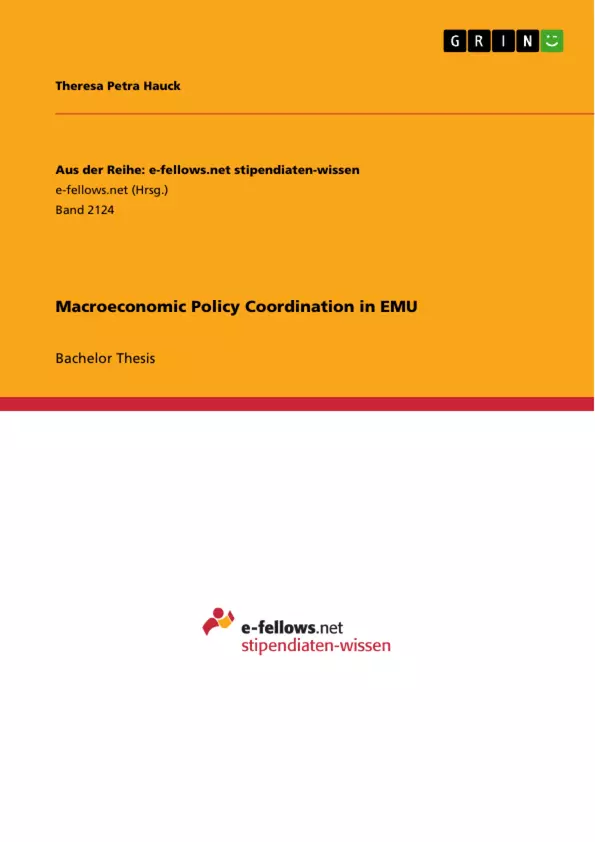The financial crisis and the subsequent European sovereign debt crisis have highlighted the high degree of interdependence among EMU member states. The crisis period made much more clear that a macroeconomic policy coordination framework is indispensable as there is great sensibility and high risk for contagion effects. The structure of EMU in its highest level of integration as of one monetary authority vis-à-vis many fiscal authorities brings about several specific aspects regarding coordination.
In order to achieve and ensure economic stability in such a unique constellation there have been established several measures and frameworks with the Stability and Growth Pact as the centre point. Designed on the grounds of and motivated by the objective of stabilising the overall economy, the pact promotes fiscal discipline through limiting government deficits and debts in order to prevent adverse fiscal spillover effects and freeriding behaviour of national fiscal authorities which could risk price and overall macroeconomic stability of the common currency area. This however brings about limitations for governments to discretionarily react to national economic needs and conditions.
This bachelor thesis addresses the resulting tension between a theoretical and fundamental need for macroeconomic policy coordination in a monetary union environment and the politico-economic reality. The main goals are: to examine the main arguments in favour and against the pact under the areas of content, objectives and enforcement design; to highlight the resulting trade-offs; and to link these to developments and reforms of the pact but also to different economic contexts, namely the time period before and the time period during and after the crisis.
The main finding is that reforms regarding macroeconomic policy coordination which were introduced after the beginning of the crisis period do not represent a rearrangement of the SGP framework and rather address the same debate on economic trade-offs only with a changed set of conditions. The reforms regarding the pact can be described as developments refocusing on the core of the pact while still shifting it in the directions of some propositions along with criticism which had been expressed long before the crisis period.
Inhaltsverzeichnis (Table of Contents)
- Introduction
- Macroeconomic policy coordination under the Stability and Growth Pact before the crisis
- Stability and Growth Pact content: numerical constraints
- Economic rationale: the role of debts and deficits as the background of the Stability and Growth Pact content
- Critical assessment: the need for country-specific constraints
- Stability and Growth Pact objective: fiscal discipline
- Economic rationale: negative externalities and the reasons of fiscal laxity
- Critical assessment: the need for discretion and flexibility
- Stability and Growth Pact governance: coordination through rules and mechanisms
- Rule-based architecture and mechanism design
- Economic rationale: The reasons for and the consequences of a rule-based framework.
- Critical assessment: credibility issues with the Stability and Growth Pact
- Stability and Growth Pact content: numerical constraints
- Macroeconomic policy coordination during and after the crisis
- The Stability and Growth Pact during the crisis
- Reforms regarding macroeconomic policy coordination
- Comparison of ante-crisis propositions and reforms
- Dimensions and trade-offs of the Stability and Growth Pact design
- Requested dimensional changes compared to actual developments of the SGP
- Conclusion
Zielsetzung und Themenschwerpunkte (Objectives and Key Themes)
This bachelor thesis aims to examine the main arguments for and against the Stability and Growth Pact (SGP) under the areas of content, objectives, and enforcement design. The thesis will highlight the resulting trade-offs and link these to developments introduced through reforms, as well as economic outcomes in different situations, namely the time period before and during and after the crisis.
- The need for macroeconomic policy coordination in a monetary union environment
- The role of the Stability and Growth Pact (SGP) in promoting fiscal discipline and ensuring economic stability in the EMU
- Trade-offs between fiscal discipline and national economic needs within the SGP framework
- Reforms of the SGP in response to the financial crisis and the European sovereign debt crisis
- Economic outcomes of the SGP before and after the crisis
Zusammenfassung der Kapitel (Chapter Summaries)
- Introduction: This chapter provides an overview of the need for macroeconomic policy coordination in the context of the EMU, highlighting the interdependence among member states and the potential for contagion effects. It introduces the Stability and Growth Pact (SGP) as a key framework for coordinating fiscal policies.
- Macroeconomic Policy Coordination under the Stability and Growth Pact before the Crisis: This chapter delves into the content, objectives, and governance of the SGP before the financial crisis. It examines the rationale behind the pact's numerical constraints on deficits and debts, as well as the criticisms and propositions regarding the need for country-specific constraints and discretion in fiscal policy.
- Macroeconomic Policy Coordination during and after the Crisis: This chapter analyzes the SGP's performance during and after the financial crisis. It discusses the impact of the crisis on the pact and the reforms implemented in response, focusing on the comparison between ante-crisis propositions and actual developments.
Schlüsselwörter (Keywords)
This bachelor thesis focuses on macroeconomic policy coordination, the Stability and Growth Pact (SGP), fiscal discipline, and economic stability in the context of the European Monetary Union (EMU). Key themes include the trade-offs between fiscal discipline and national economic needs, the impact of the financial crisis and the European sovereign debt crisis on the SGP, and the reforms implemented in response to these crises.
- Arbeit zitieren
- Theresa Petra Hauck (Autor:in), 2016, Macroeconomic Policy Coordination in EMU, München, GRIN Verlag, https://www.grin.com/document/340157



